CLOWN FATALE #1 (Dark Horse Comics, $3.99)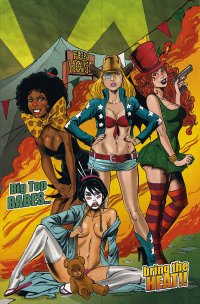
By Devon Sanders
“He didn’t have to treat us like scum! We may be clowns, but it’s not like we’re rodeo clowns. For the love of God, we’re not rodeo clowns!”
Two days after reading Clown Fatale #1 and I’m still trying to figure out if it’s f***ing brilliant or brilliantly f***ed.
Writer Victor Gischler’s Clown Fatale is, I believe, just one brilliant genre troll.
There are four women clowns. One is a redhead. One, a blonde. The other two, of course, black and nondescript Asian. None wear clothes a lot.
It has the barest thread of a plot; four hard living buxom women with checkered pasts fall into… clowning, finding sisterhood while desperately searching for respectability. When presented with the opportunity, they grab it and gut it and what comes next is a bender of murder, guns and getback.
Add in a threesome of knife throwing circus hit men looking for trouble and well…
Clown Fatale‘s pretty terrible but I say that in the best way imaginable.
There’s nothing of any redeeming value here. Clown Fatale knows it’s best read to the soundtrack of Ke$ha. It’s bad but knowingly so.
If there’s anything good I can say about Clown Fatale is that artist Maurizio Rosenzweig knows what he’s there for; draw women. Women shooting. Women walking away from burning buildings. Women drinking whiskey in their underwear. If this is what you came for, he never let’s you down. Somehow, in all of this, he manages to convey that yes, there still is a bit of plot somewhere that needs following.
Clown Fatale #1 has value only if you place any within it. That can be said of most art. You’ll just have to pick it up to see for yourself.
*I’m not giving it a rating because… Clown Fatale #1 just may defy reviewing.
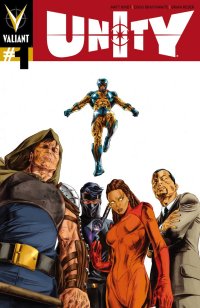 Unity #1 ($3.99, Valiant)
Unity #1 ($3.99, Valiant)
by D.S. Randlett (@dsrandlett)
My backlog of Valiant comics is getting pretty severe, so I didn’t quite know what I was getting into when I decided to hop in on a series that’s been billed as something of new phase in the line’s continuity. What I liked a lot about Valiant’s first year was that, across the line, they seemed to have their finger on the pulse of the anxieties that are currently permeating the culture. And then they wrapped that consciousness up in gory, funny, and above all thrilling pseudo-superhero stories. Bloodshot was about the ultimate Iraq War vet, Harbinger was about a band of transient Occupiers, Archer and Armstrong was a tour through all of the weird conspiracy theories that permeate our culture. It was natural to root for the characters in these books because they were not only the underdogs, but they were underdogs beset by wacked out versions of the issues at the center of modern day everyday oppression.
But all along the line’s had another angle gathering steam, particularly in the pages of X-O Manowar. Unlike the other series in Valiant’s first year, X-O seemed to relish in Aric of Dacia’s power: imagine if Conan the Barbarian had Iron Man’s armor. That’s who he is, basically. Once the first arc was over, Aric found himself as a man out of time, without a people or a nation. These two things were at the core of how the character saw himself, so he set out to rectify that. That’s where I stopped reading (but still buying, like I said, I have a backlog of this stuff) Valiant comics. You know how it is.
Unity, thankfully, gives you everything you need to know at the outset. Aric of Dacia has conquered Romania, and settled it with the remnants of his rescued Dacians. Right off the bat, writer Matt Kindt (whose star has officially risen, I think it’s safe to say) gets at the heart of what makes this character interesting: you should be afraid of him. Sure, he has a noble, primal, warrior’s morality, but he’s basically Genghis Khan with alien technology at his disposal. X-O Manowar, as a concept, would be utterly boring if not for this, and Kindt gets to the heart of the matter: Aric of Dacia represents the unleashed force of humanity’s past conquerors.
Kindt’s treatment of the X-O Manowar concept comes to encapsulate what Unity is basically about. It’s the other side of the Valiant Universe coin. Where titles like Archer and Armstrong, Harbinger, and Bloodshot call oppressed groups to mind, Unity calls to mind the oppressors. They are the One Percent. They are power. Definitely a different way to look at what is ostensibly a “team book,” especially in an introductory arc that involves Toyo Harada (the big bad from Harbinger) assembling a team of badasses to outflank the emergence of a threat to the existing power structure, Aric of Dacia. Kindt’s story, like much of Valiant’s other output, is half superhero and half… something else, here a geopolitical technothriller. There’s the potential here for something really cool and different in the realm of current team books. After all, Kindt plays these characters more like world powers than heroes, so there’s the potential for lots of crunchy politics and backstabbing here to go with the superhero punch ups.
I like Doug Braithwaite’s art, but I’ve always been ambivalent about his storytelling, and that’s the case here. His figures and compositions are immaculate, and the inkless coloring looks really good here. Braithwaite captures the book’s quieter, talkier moments very effectively. He has a real gift for expressing character through facial expressions, and it really makes the exposition come to life here. Scenes that call for a bit more dynamism don’t fare as well. They’re never inert, but they often feel very matter of fact, which is certainly appropriate for more than one of the “fights” here, but there are some scenes involving Ninjak that could have benefitted from a different take. This is not to say that Braithwaite’s art is at all bad. It’s not at all, but there are scenes that could use a bit more zest.
Unity is a new step for a bold line of comics, and well worth checking out. Even for new readers.
Rating: 




Out of a Possible 5 Stars
Captain Marvel #17 (Marvel, $3.99)
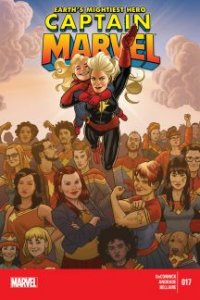
By Adam X. Smith
Read it. Seriously. Just read it.
Okay, joking aside, I went into this book with only limited knowledge and previous experience of Carol Danvers aka the Hero Formerly Known as Ms Marvel – the most recent being Warren Ellis’ Avengers: Endless Wartime, with some supplementation from Bob Chipman’s informative videos on her backstory here and here . So it’s with trepidation that I bought this issue of a series that has been getting near-universal praise from everyone I know who has read it. So here I go once again with the Johnny-Come-Lately act and tell you what everyone and their kid sister should already know by now: it’s damn good.
Almost as if the book telepathically knew of my unfamiliarity with it – don’t you just love it when that happens – it turns out that in a stunning turn of events Carol has been stricken with amnesia and is doing her best to piece back together her own life. Oh, and to this end there is a little eight-year-old girl Carol is friends with who is a little more on the ball than most kids her age, but is otherwise a sweet and affecting presence. Meanwhile, Carol’s problems are only complicated by her having nowhere to live, friends who fall at different spaces on the spectrum of helpfulness, and being offered the key to the city by Mayor J Jonah Jameson (yeah, I keep being reminded of that and it still is incredibly weird considering he’s essentially just a cartoon character).
While this is all going on, we get to see Grace Valentine – a striving career woman having a particularly bad day at the office – place blame for all her problems Doctor Doom-style on Captain Marvel and hacks some military drones (as well as the screens in Time Square*) to attack the awards ceremony. Of course her attempts to slander the good Captain are thoroughly rejected by the people of New York City in a scene right out of Spartacus.
Look, I’m not going to get into the whole affirmative action versus positive representation of women in comics debate here – not because it’s beneath me**, but simply because I’m on a deadline here – but one takeaway I got from Grace Valentine as what I can only assume is being set up as a recurring nemesis role is how she contrasts so sharply with the heroine. Indeed, in her first pages, you feel sorry for her. But the reason she is a villain, and why she fails to succeed as both a person and as an antagonist, is she bases her beliefs and aspirations on flawed principles and double standards. Her rejected article is about her objectivist philosophy – which wouldn’t normally be a problem, but it’s objectivism through the cracked glass of self-interest and social Darwinism (god I hate it when people use Darwin to justify selfishness). Her partner reminds her that she is already a highly successful CEO and founder of a tech company and a systems genius – none of which matters to her; to Grace it’s simply not enough to be anything other than the most successful and beloved person in the world, because if you’re in business and a woman, that’s the standard you’re held to. In lesser hands, she would be a shrill straw feminist harpy – in the hands of Kelly Sue DeConnick, I came dangerously close to empathising with this woman who has been raised to believe in a toxic form of self-determination where aggression is the preferred means of achieving success. And then it turns out her killer app has secretly been collecting user information for reasons not yet known and it turns out she really is a distaff Lex Luthor in training, so it turns out it’s okay to hate her stupid guts.
Carol, by contrast, represents everything that is good and pure about womanhood without conforming to the cliché of being a chesty bimbo or a chaste ingénue. Her memory loss makes her come off as vulnerable (despite her insistence to the contrary) but not hysterical. She hastily invites the affection of a friend not knowing whether they were in a relationship previously, but rather than reject the advance, they decide to just hang out so she won’t be lonely. Grace tries to discredit her by calling her an alcoholic, an alien and an undisciplined brain-damaged disaster, but it only proves that she is just as flawed and troubled as everyone else, and her success in spite of this makes her beloved. She’s like everyone’s favourite big sister. Except she can fly and shoot energy out of her hands.
Props to DeConnick and artist Filipe Andrade for showing that you can write comics about women for an all-genders audience without it being boring or full of boobs that just so happen to have characters attached to them.
Rating: 




Out of a Possible 5 Stars
*Seriously, again with the Times Square Jumbotron thing? I get it, NYC has a thing for advertising and it makes a good image, but surely the companies that maintain those screens lose a chunk of money from potential advertisers who think that anyone with a laptop and decent wifi speed can scramble them every time they want to deliver their doomsday manifesto.
**QED, my open letter to DC Comics, hosted on this very editorial here.
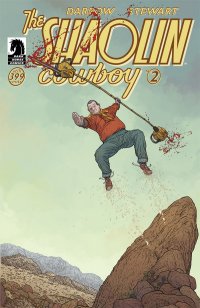 Shaolin Cowboy #2 (Dark Horse, $3.99)
Shaolin Cowboy #2 (Dark Horse, $3.99)
by Graig Kent
Perhaps you thought the first issue of Shaolin Cowboy was a tad too brisk, too light on story, and frustratingly lacking in any real substance beyond Geoff Darrow’s insanely intricate artwork. Well, by those standards, you’re going to like issue 2 even less.
This second issue is perhaps one of the most fascinating comics I have ever read… and by “read”, I mean “looked at” because there’s not a single line of dialogue and no word balloons. There’s no words at all, in fact, beyond the credits inside the front cover and the continuous sound effect of the double-chainsaw mounted staff rumbling across the top of the page.
This oddly-sized 33-page unstory starts with a splash page (where we left off last issue) of the Cowboy leaping into a horde of zombies. From there it’s 16 double-page spreads, consisting of two equally sized widescreen panels stacked one on top of the other following the movement of the Cowboy as he kicks ass and rends flesh. It, quite literally, is one big fight sequence, or rather, a segment thereof. Were it a movie it would be about 40 seconds of screentime. A minute, tops. Two minutes if Zack Snyder’s directing it.
It’s one against hundreds, and Darrow shows in painstaking detail how the Cowboy progresses through the throngs one step at a time. It’s a ridiculous book, all things considered. If you were to read it for story it would take literally seconds to get through, but it’s Geoff Darrow and you can get lost in his nuances for half an hour or more. But it’s gross. Really, uncomfortably gross. Piles of naked zombies of both sexes getting rendered and savaged by chainsaws and kung-fu, Darrow sparing us no gory detail.
Beyond the blood and guts, there’s the poetry of the Cowboy’s movements. It’s so natural it’s easy to overlook. Each step in the fight picks up from the last and leads into the next. Your mind fills in the blanks but you can see how from one position his body arrived at the next. I’m certain after this that Darrow could draw an actual ballet, were he so inclined, and I would read it.
This is an audacious comic. I’ve never had need of that word before but it fits here. I’m not even sure I like it, but it’s just so different than anything I’ve ever seen, and I’ve read thousands upon thousands of comics to mind-melting effect. I am in awe. It won’t be the same reading it in the inevitable collected edition, where it will just feel like the drawn-out illustrating of a fight, but here as a floppy, it’s a unique artifact, true artistic expression wrapped in the middle of a silly genre mash-up.
Rating: 




Out of a Possible 5 Stars
X-Men Gold #1 (Marvel. $4.99)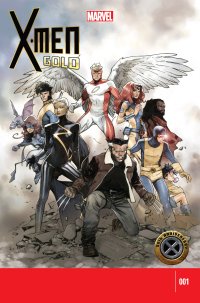
By Jeb D.
These days, it’s inevitable to scrutinize any “special” comic from the Big 2 with an eye toward multi-media convergence, and editor Nick Lowe makes it explicit that this 50th Anniversary anthology celebration of the X-Men is aimed at lapsed X readers who are presumably getting the itch again as the buildup to the “Days of Future Past” film rolls on. And, to be fair, they’ve done a decent job of actually assembling a group of creators who do represent the broad range of development in Marvel’s sprawling mutant (soon to become Inhuman?) franchise. And, like most anthologies, it works in little bits and pieces, but as an overall purchase, is probably more for the completist or collector than anyone looking for a stimulating reading experience.
One of the problems with trying to re-introduce old fans to the X-Men is that their glory years (which, realistically, was pretty much the Claremont era) worked on the basis of long, layered storylines, and soap-opera plot construction; even the 2-issue “Days of Future Past” owes much of its effectiveness to the groundwork that had been laid in the issues leading up to it (and which is why it’s a better choice for the seventh X-Men film, than it would have been for the second or third). Old-time fans reading this comic may have some vague nostalgic reactions to seeing familiar faces again, particularly given the fact that these are mostly “period pieces,” but I’m not sure how that will translate into selling them on the current X geography.
Individually, we open with the longest piece, a Chris Claremont story pitting the 70’s-era X-Men (the introduction of Rogue to the team is part of the storyline) against some self-replicating Sentinels. Claremont’s best days are long past, of course, but even so, the talkiness and name-drop signposting of this story prevent any sort of flow or reader involvement. It’s almost worth it, though, to see what modern production techniques and coloring do to artist Bob McLeod’s old-school pencils… nothing good, I’m afraid, but it’s weird enough to be work a look.
Walt Simonson’s return to Marvel last year was a full-length romp with the Avengers; this brief glimpse of the X-Men barely gives the reader time to reacquaint themselves with the original team (well, for those reading currently, we’ve recently seen a lot of the original team… ), and its four pages have the interesting credits of Story by Louise Simonson, Dialog by Stan Lee. It’s certainly fun to have more bombastic word balloons from Smilin’ Stan, but why they needed to recruit the fully capable Simonson to sketch out the “plot” for a silly, soapy trifle on top of that baffles me.
Did you know that, before they joined the X-Men, both Sunfire and Banshee were Sun Records rockabilly fanatics? Does that inform your knowledge of the characters? I will say that at least Roy Thomas and Pat Olliffe stop short of having them do Elvis impersonations.
Len Wein and Jorge Molina take us back to “Xavier Mansion… Day One,” with Wolverine spending some time musing over how he’d take down various members of the team, should the need arise, and the fantasized mayhem ends with such a cheerful smile on Logan’s face that I felt queasy for just having read it.
Finally, another X “dream team,” writer Fabian Nicieza and artist Salvatore Larroca, work up a dull, grim story of Xavier, Magneto, and the death of a dream that is not only unattractive on its own terms, but about as poor an enticement to keep reading X-Men comics as one could imagine.
I lost touch with the X franchise some years ago-an inevitability, really, as with rare exceptions (Si Spurrier’s X-Men:Legacy is probably the best recent example), getting the most out of Marvel’s mutants involves something resembling full immersion, and not one segment of this comic would entice you to do that.
Plus, did I remember to mention that fucking Nightcrawler’s not dead again? No, that was last week. Either way, enough already.
Rating: 




Out of a Possible 5 Stars